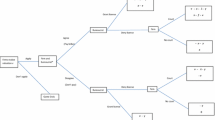Abstract
The aim of the article is to examine a briber initiated corrupt transaction and the role of intermediaries in such a transaction, using a game theoretical model. Clients applying the intermediaries do so to be able to get rid of high red tape applied by the officers. They prefer using intermediary instead of offering a bribe to the officers directly since they do not know which officers are corrupt (accepts a bribe offer) and how much bribe should be given to the corrupt officers.
In our model, the client wants to offer a bribe to get rid of red tape, however, she hesitates due to the possibility of offering a bribe to an honest public officer and as a result getting a penalty. Client also hesitates due to the possibility of offering an amount of bribe lower than the reservation price of the corrupt officer; thus being rejected. Intermediaries, knowing which officers are corrupt and the reservation prices of those corrupt officers, decrease the risk of offering a bribe.
Two cases; one with intermediary, the other without, in such a scenario is examined and the results of the two are compared.
Similar content being viewed by others
References
Albano, G.L. and Lizzeri, A. (2001). Strategic certification and provision of quality. International Economic Review 42:267–283.
Andvig, J.C. and Moene, K.O. (1990). How corruption may corrupt. Journal of Economic Behavior and Organization 13:63–76.
Bayar, G. (2003). Corruption–A game theoretical analysis. Ph.D thesis. Ankara: Middle East Technical University.
Biglaiser, G. (1993). Middlemen as experts. RAND Journal of Economics 24:212–223.
Cadot, O. (1987). Corruption as a gamble. Journal of Public Economics 33:223–244.
Gehrig, T. (1993). Intermediation in search markets. Journal of Economics and Management Strategy 2:97–120.
Jain, K.A. (2001). Corruption: A review. Journal of Economic Surveys 15:71–121.
Lizzeri, A. (1999). Information revelation and certification intermediaries. Rand Journal of Economics 30:214–231.
Lui, T.F. (1986). A dynamic model of corruption deterrence. Journal of Public Economics 31:215–236.
Macrae, J. (1982). Underdevelopment and the economics of corruption: A game theory approach. World Development 10:677–687.
Manion, M. (1996). Corruption by design: Bribery in Chinese enterprise licencing. The Journal of Law, Economics and Organization 12:167–182.
Mauro, P. (1998). Corruption: Causes, consequences and agenda for further research. Finance and Development 35(1):11–14.
Rubinstein, A. and Wolinsky, A. (1987). Middlemen. Quarterly Journal of Economics: 102(3):581–593.
Shleifer, A. and Vishny, R.W. (1993). Corruption. The Quarterly Journal of Economics 108:519–617.
Author information
Authors and Affiliations
Corresponding author
Additional information
I wish to thank Tarik Kara, Hakan Ercan, İsmail Sağlam and an anonymous referee for their very helpful comments and suggestions.
Rights and permissions
About this article
Cite this article
Bayar, G. The role of intermediaries in corruption. Public Choice 122, 277–298 (2005). https://doi.org/10.1007/s11127-005-5916-8
Accepted:
Issue Date:
DOI: https://doi.org/10.1007/s11127-005-5916-8




